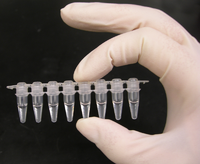
Photo from wikipedia
Sensitive and accurate RT-qPCR tests are the primary diagnostic tools to identify SARS-CoV-2-infected patients. While many SARS-CoV-2 RT-qPCR tests are available, there are significant differences in test sensitivity, workflow (e.g.… Click to show full abstract
Sensitive and accurate RT-qPCR tests are the primary diagnostic tools to identify SARS-CoV-2-infected patients. While many SARS-CoV-2 RT-qPCR tests are available, there are significant differences in test sensitivity, workflow (e.g. hands-on-time), gene targets and other functionalities that users must consider. Several publicly available protocols shared by reference labs and public health authorities provide useful tools for SARS-CoV-2 diagnosis, but many have shortcomings related to sensitivity and laborious workflows. Here, we describe a series of SARS-CoV-2 RT-qPCR tests that are originally based on the protocol targeting regions of the RNA-dependent RNA polymerase (RdRp) and envelope (E) coding genes developed by the Charité Berlin. We redesigned the primers/probes, utilized locked nucleic acid nucleotides, incorporated dual probe technology and conducted extensive optimizations of reaction conditions to enhance the sensitivity and specificity of these tests. By incorporating an RNase P internal control and developing multiplexed assays for distinguishing SARS-CoV-2 and influenza A and B, we streamlined the workflow to provide quicker results and reduced consumable costs. Some of these tests use modified enzymes enabling the formulation of a room temperature-stable master mix and lyophilized positive control, thus increasing the functionality of the test and eliminating cold chain shipping and storage. Moreover, a rapid, RNA extraction-free version enables high sensitivity detection of SARS-CoV-2 in about an hour using minimally invasive, self-collected gargle samples. These RT-qPCR assays can easily be implemented in any diagnostic laboratory and can provide a powerful tool to detect SARS-CoV-2 and the most common seasonal influenzas during the vaccination phase of the pandemic.
Journal Title: Microbial biotechnology
Year Published: 2022
Link to full text (if available)
Share on Social Media: Sign Up to like & get
recommendations!